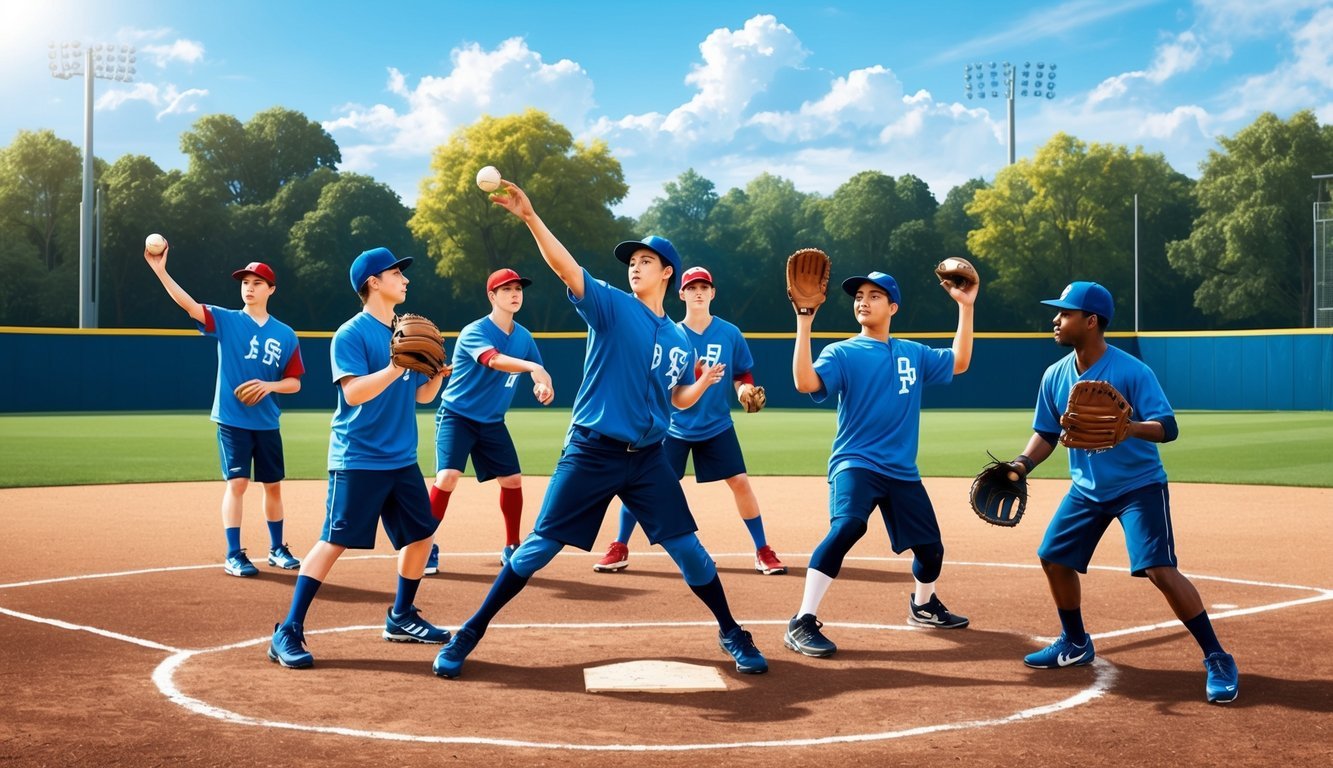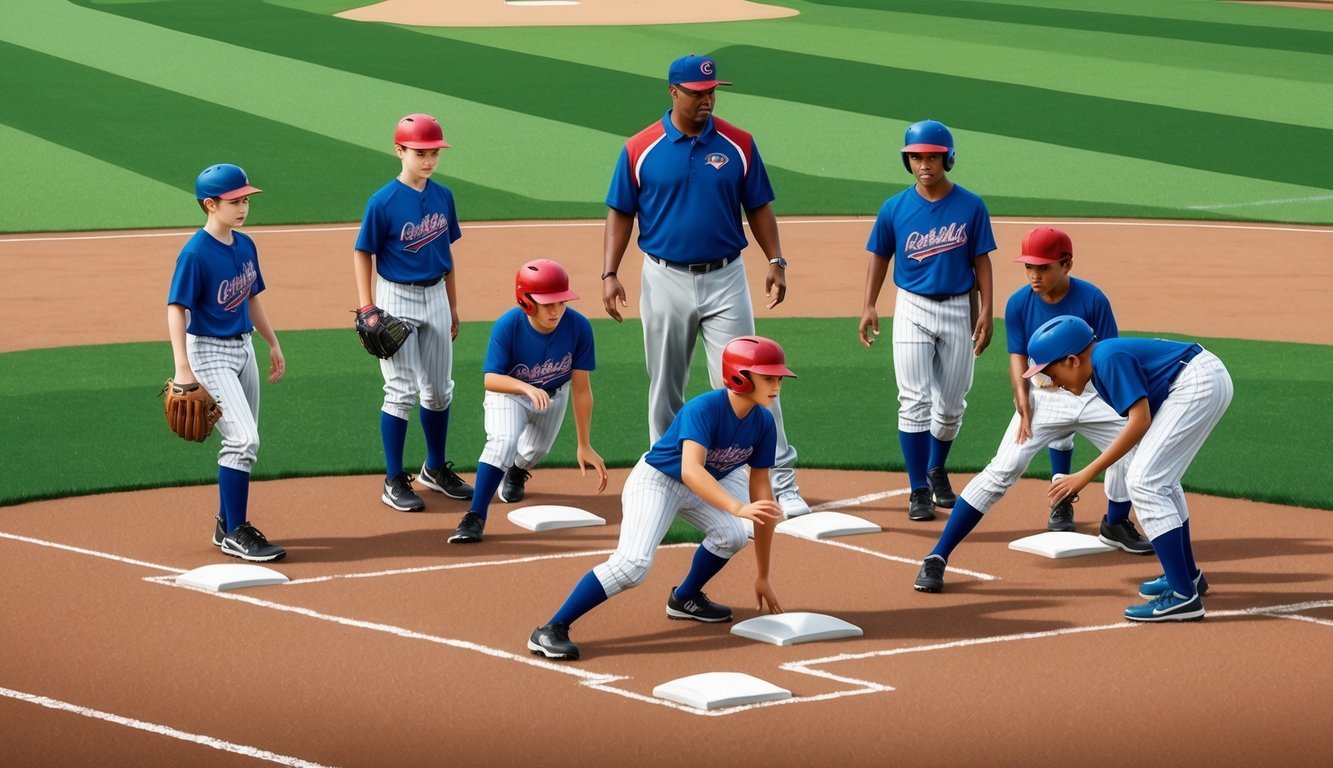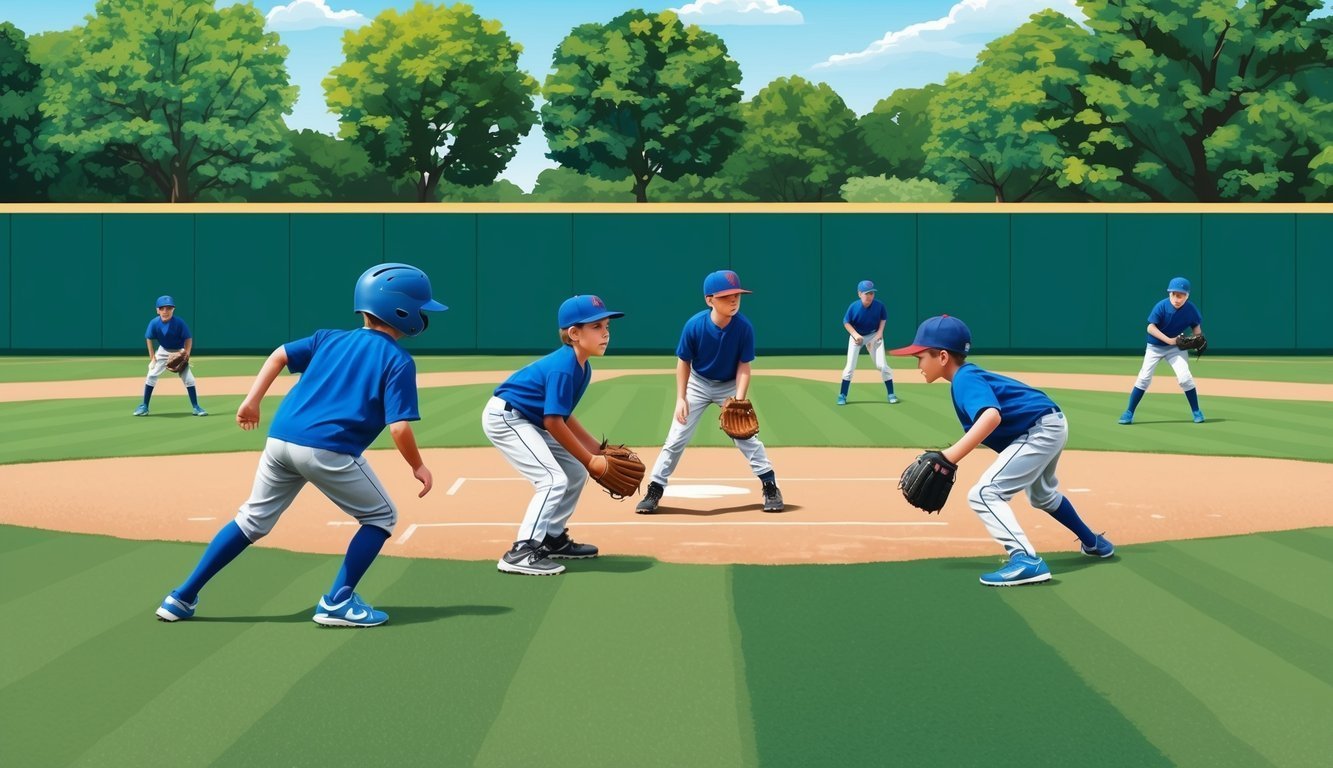Youth infield drills are essential for developing fundamental baseball skills and shaping future star players.
These exercises focus on improving fielding techniques, hand-eye coordination, and quick decision-making abilities. Effective youth infield drills can transform young players into confident and skilled infielders, capable of making game-changing plays.
Coaches and parents alike recognize the importance of these drills in nurturing talent and fostering a love for the game.
From the Barry Larkin Pancake Glove Drill to circle drills with short fungos, there’s a wide array of exercises designed to challenge and engage young athletes.
These drills not only enhance technical skills but also promote teamwork and communication on the field.
By incorporating fun and varied infield drills into practice sessions, coaches can keep young players motivated and eager to improve.
Whether it’s mastering the art of fielding ground balls or perfecting the timing for catching line drives, these drills lay the foundation for success in youth baseball and beyond.
Fundamentals of Infield Play
Infield play requires a combination of quick reflexes, proper technique, and mental sharpness.
Mastering the basics sets the foundation for exceptional defensive skills on the baseball diamond.
Equally important is mastering outfield baseball techniques, as outfielders must be adept at catching fly balls and making accurate throws to prevent runners from advancing.
This comprehensive understanding of both infield and outfield dynamics enhances a player’s overall performance and contributes to a team’s defensive strength.
With dedication and practice, players can elevate their game and become defensive assets in any situation.
Developing Soft Hands
Soft hands are crucial for fielding grounders cleanly.
Players should practice receiving the ball with relaxed, flexible hands to absorb its energy.
This technique minimizes bobbles and increases control.
A useful drill involves rolling grounders to players from a short distance.
Start barehanded to focus on hand positioning and feel.
Gradually increase distance and add gloves as skills improve.
Encourage players to watch the ball into their hands.
This develops hand-eye coordination and helps prevent errors.
Soft hands also apply to catching throws from teammates.
Mastering Footwork and Positioning
Proper footwork enables infielders to react quickly and cover more ground.
Players should stay on the balls of their feet, ready to move in any direction.
A low, athletic stance with knees bent provides balance and agility.
Practice lateral movements and quick first steps.
Shuffle steps help maintain body control when fielding to the side.
Crossover steps are useful for covering larger distances quickly.
Positioning varies by position but generally involves anticipating where the ball might be hit.
Infielders should adjust based on the batter, game situation, and coach’s signals.
Fielding drills that incorporate movement, such as the circle drill, help players develop proper approach angles to grounders.
This improves their ability to field the ball in front of their body and make strong throws.
Infield Drills for Skill Enhancement
Developing strong infield skills requires consistent practice and targeted drills.
These exercises focus on essential techniques to improve fielding, coordination, and game-readiness for young players.
Routine Ground Balls Drill
Players pair up and take turns rolling ground balls to each other.
Start with bare hands to emphasize soft hands and proper ball tracking.
Gradually increase distance and speed as players improve.
Coaches can introduce variations like short hops or slow rollers.
For added challenge, draw a circle in the dirt.
Position players 10-15 feet behind it, requiring them to field the ball within the circle.
This drill helps develop an aggressive approach to ground balls.
Incorporate a timer to create friendly competition.
Players aim to cleanly field a set number of ground balls in the shortest time possible.
Double Play Drills
Set up bases and divide players into groups of three: a shortstop, second baseman, and first baseman.
The coach hits ground balls to either middle infielder, who fields and throws to their partner.
The receiving player then turns and throws to first base.
Emphasize quick transfers and accurate throws.
Encourage players to communicate and call the play.
Add baserunners to simulate game situations.
This helps infielders develop awareness and practice proper footwork around the bag.
For younger players, start with slower grounders and shorter distances between bases.
Gradually increase speed and difficulty as skills improve.
Backhand and Forehand Drills
Line up players in two rows facing each other, about 15 feet apart.
One row tosses balls to their partner’s backhand side, while the other row fields and returns the ball.
Switch sides after a set number of repetitions.
Focus on proper glove positioning and footwork.
Players should practice moving their feet to get in front of the ball when possible.
Introduce the crossover step for balls hit further to the side.
This helps players cover more ground efficiently.
For forehand practice, repeat the drill with tosses to the glove side.
Emphasize using two hands to secure the ball after fielding.
Fungo Ground Balls
Coaches use fungo bats to hit a variety of ground balls to infielders.
Start with routine grounders directly at players, then progress to balls hit to their left and right.
Mix in different types of hits: slow rollers, short hops, and line drives.
This variety helps players react to game-like situations.
Incorporate game scenarios by calling out situations (e.g., “runner on first, one out”).
Players must field the ball and make the appropriate play.
For younger players, use softer balls or tennis balls to build confidence.
Gradually transition to regulation baseballs as skills improve.
End each session with a fun game like “Around the Horn” to practice throws between all infield positions.
Improving Throwing and Catching Techniques

Mastering throwing and catching techniques is crucial for young infielders.
These skills form the foundation of solid defensive play and can make a big difference in game situations.
Throwing Accuracy Exercises
Accuracy drills help players develop pinpoint throws.
Set up targets at different distances and have players aim for them.
Start with large targets and gradually decrease their size as skills improve.
Use cones or hula hoops as targets.
Players can compete to see who hits the most targets in a set number of throws.
This adds a fun, competitive element to practice.
Incorporate different throwing positions – standing, kneeling, and moving laterally.
This mimics real game scenarios and builds versatility.
Catching and Quick Transfer
Quick hands are essential for infielders.
Practice bare-handed catches to improve hand-eye coordination.
Start with soft tosses and increase speed as players get comfortable.
Use tennis balls for soft-hands drills.
Players should focus on catching the ball softly, as if it were an egg.
This teaches proper glove positioning and reduces bobbles.
Work on quick transfers from glove to throwing hand.
Set up relay lines where players catch and quickly throw to the next person.
Time the drill to encourage speed and efficiency.
Four Corners Drill
The four corners drill combines throwing, catching, and footwork.
Place four players in a square formation, about 15-20 feet apart.
Players throw the ball clockwise, focusing on accurate throws and proper footwork.
After each throw, the player moves to receive the next throw.
Add a second ball to increase difficulty and simulate game-like pressure.
This forces players to stay alert and make quick decisions.
Vary the drill by having players field ground balls before throwing.
This adds a fielding element and mimics double-play scenarios.
Speed and Agility Training

Speed and agility are crucial skills for young infielders.
These attributes enhance reaction times, improve fielding ability, and boost overall performance on the diamond.
Quick Feet Ladder Drills
Agility ladders are excellent tools for developing quick feet and coordination.
Players can practice various patterns like high knees, lateral shuffles, and in-and-outs.
These drills improve footwork speed and precision.
Start with simple patterns and gradually increase complexity.
Encourage players to maintain a low, athletic stance throughout the drill.
This mimics the ready position infielders need on the field.
Incorporate baseball-specific movements into ladder drills.
For example, players can practice crossover steps or simulate charging a ground ball.
This helps transfer agility skills directly to game situations.
Directional Change Drills
Rapid directional changes are essential for infielders reacting to batted balls.
Cone drills offer a great way to practice quick pivots and acceleration.
Set up cones in a zigzag pattern.
Players sprint to each cone, touch it, and change direction sharply.
This drill enhances their ability to explode in different directions quickly.
Another effective drill involves randomly calling out directions.
Players must react and sprint accordingly.
This improves anticipation and quickness, mirroring the unpredictable nature of infield play.
Incorporate baseball movements into these drills.
For instance, players can field a ground ball at each cone before changing direction.
This combines agility training with essential fielding skills.
Planning and Running Effective Practice Sessions

Organizing structured and engaging practice sessions is crucial for developing young infielders’ skills.
A well-planned approach maximizes learning opportunities and keeps players motivated.
Creating Dynamic Practice Plans
Mix up drills and activities to maintain players’ interest.
Start with a brief warm-up, then rotate through stations focusing on different skills.
Include groundball practice, throwing accuracy drills, and fielding exercises.
Incorporate fun competitive elements like timed challenges or team-based games.
Keep sessions moving at a brisk pace to prevent boredom.
Adjust plans based on players’ energy levels and attention spans.
End practices with a team-building activity or scrimmage to boost morale.
Utilizing Appropriate Equipment
Choose gear suited to young players’ abilities.
Softer baseballs or tennis balls can help build confidence for beginners.
Use wiffle balls for certain drills to reduce the risk of injury.
Set up portable pitching machines for consistent grounders and fly balls.
Utilize cones to mark drill areas and create targets.
Invest in lightweight, youth-sized gloves and bats for proper skill development.
Ensure all equipment is in good condition and appropriate for the drill at hand.
Focus on Player Development
Tailor drills to individual skill levels.
Observe each player’s strengths and weaknesses, then design targeted exercises to improve specific areas.
Provide positive reinforcement and constructive feedback.
Teach proper techniques for fielding, throwing, and positioning.
Emphasize fundamentals like footwork, glove positioning, and transfer skills.
Gradually increase difficulty as players progress.
Encourage teamwork and communication during drills.
Foster a supportive environment where players feel comfortable making mistakes and learning from them.
